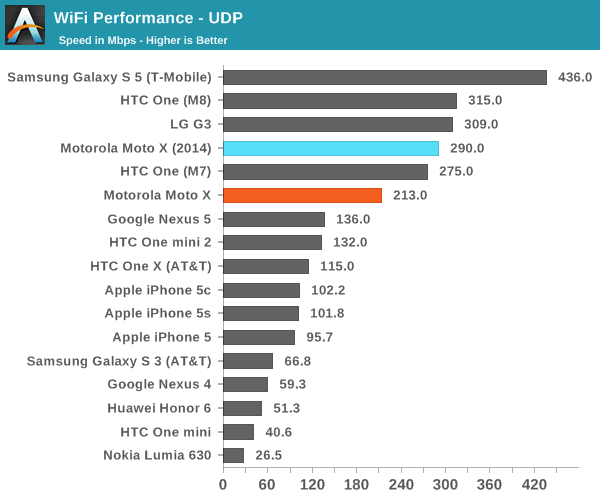The New Motorola Moto X (2nd Gen) Review
by Joshua Ho on September 17, 2014 9:00 AM EST- Posted in
- Smartphones
- Motorola
- Android
- Mobile
WiFi Performance
For the most part, WiFi performance is generally driven forward due to an increasing need for better battery life and higher speeds. In order to get a closer look at this, we use iperf on UDP mode. In the case of the Moto X, we see that the WiFi solution continues to be the same WCN3680 that is quite popular amongst OEMs as a 1x1 802.11ac solution. In order to get ideal performance, the phones are connected to Asus' RT-AC68U router as the sole client in order to try and eliminate the router as a gating factor.

As one can see, there's a mild performance uplift compared to the previous Moto X. The Samsung Galaxy S5 continues to lead because of its 2x2 MIMO solution, but the new Moto X doesn't give any reason for concern when it comes to WiFi performance.
GNSS
While at this point GNSS reliability is not nearly the issue that it was in early smartphones, there are still some differences to be had. For the most part though, any phone with a Qualcomm modem is utilizing IZat to enable GPS. In the case of the Moto X and Snapdragon 801 phones, this is IZat Gen 8B. Any lock with the cellular radio on is incredibly fast as the initial time and location data from the modem drops time to first lock to about 8 seconds in good conditions. From a cold start without assistance data and on airplane mode, it takes about 30 seconds to get a location fix. The Moto X seems to have a strong GPS antenna, and it's relatively easy to reach 10 foot accuracy if the sky is visible.
Misc.
Unfortunately with these reviews it isn't feasible to cover every aspect in the level of detail that I'd like to, but I still want to mention some of my observations. First, the TFA9890 speaker amp seems to only drive one speaker at a time, and while the lack of stereo speaker functionality is a bit disappointing the speaker gets quite loud, and feels comparable to the M8 in sheer volume. There is a BCM2079x NFC controller in the Moto X, and tap and pay with Google Wallet seems to work. I also see an Atmel touchscreen but I'm unsure what family it falls under as there isn't any public information on the model. The same TPA6165 amplifier is used for the headphone jack as on the previous Moto X, so any improvements will come from the new audio codec in Snapdragon 801 when compared to Snapdragon S4 Pro. In addition, while I don't have a setup to test noise cancellation I wanted to note that Motorola has made their own custom solution for noise cancellation instead of using an Audience or Qualcomm Fluence solution. Finally, if the "STM401 Sensor Processor" is really the STM32F401CC MCU made by ST-Microelectronics, there's potential to integrate similar functionality into Samsung Galaxy S5 as it has a similar IC for sensor hub functionality.











179 Comments
View All Comments
coder543 - Wednesday, September 17, 2014 - link
Nope.Flunk - Wednesday, September 17, 2014 - link
That's right, it's only been 39 nears since the "Metric Conversion Act" of 1975. Not 100 years.theuglyman0war - Thursday, September 18, 2014 - link
Not sure but wasn't the Metric Conversion Act a direct response to some initial action made by Woodrow Wilson? At least that is what I was taught in grade school in the 70's.What is really irksome is that despite there being a massive campaign by school systems to make the date where we were actually getting a handle on the metric conversion at the time...
Because all the "grown ups" at the time were waving their hands and running around like chickens yelling "it's useless!" "it's useless!" the whole program died an unfair death even though we were learning and understanding the world in metric just fine!
( now that I am 50 and forgot how to look at the world in units of 10 it is officially useless! )
keithzg - Monday, September 22, 2014 - link
Yeah, the resistance by "grown ups" to the Metric system was, and continues to be, pretty ridiculous. I mean, units of 10? However will I conceptualize that?!?! It's not like it equals the count of my fingers, or my numerical system is based on that or anything!melgross - Thursday, September 18, 2014 - link
Actually, it was back in 1866 that Congress passed a law requiring businesses and government to convert to metric as soon as possible, and to begin teaching it in schools. Unfortunately, no one paid attention.usernametaken76 - Wednesday, September 17, 2014 - link
What size screen does your phone have again?soccerballtux - Thursday, September 18, 2014 - link
ouchhhhhhh heheRatman6161 - Wednesday, September 17, 2014 - link
My fellow Americans: 1 inch = approximately 25mm. But really does it matter? The numbers are just so you can compare it to other phones so as long as all the reviews use a consistent unit of measure, why does it matter? Just saying. If it does matter to you, wip our your calculator.Arkive - Wednesday, September 17, 2014 - link
Wow. I was born and raised in America and even I am astonished by this comment. Seriously, we are not the only ones reading these articles, plus, metric is clearly better than our randomly generated units of measurement.Fergy - Wednesday, September 17, 2014 - link
If you give someones height as 5 feet 2 inch it is even worse.1 feet = 30.48cm, 1 inch = 2.54cm
5x30.48cm=152.4cm + 2x2.54cm=5.08cm
152.4cm+5.08cm=157.48cm
So that is 157.48cm or 1.5748m. I get that you grew up with the imperial system but the metric system is so much easier to use and it is the default for science.